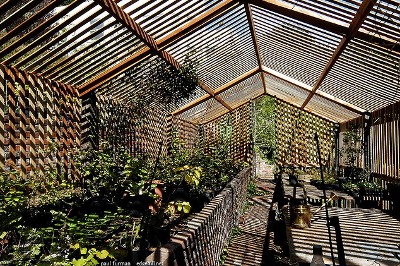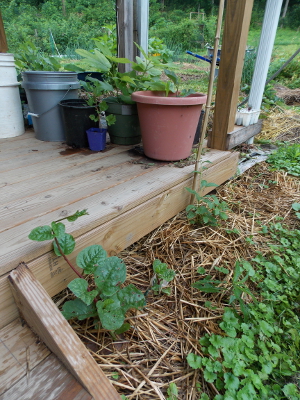
Shade houses
 One of my favorite
chapters in Bill Mollison's Introduction
to Permaculture was the one on housing. In addition to
all of the mainstream information on passive solar (with or
without an attached greenhouse), closing and opening windows to
manage air temperature, thermal mass, and shade trees, he
introduced a concept I'd never heard of --- the shade house.
One of my favorite
chapters in Bill Mollison's Introduction
to Permaculture was the one on housing. In addition to
all of the mainstream information on passive solar (with or
without an attached greenhouse), closing and opening windows to
manage air temperature, thermal mass, and shade trees, he
introduced a concept I'd never heard of --- the shade house.
A search of the
internet suggestions that Mollison's shadehouse may sometimes be
known as a lathe house. Regardless of the name, the
structure is placed on the north side of the home in our
hemisphere, has a partially covered top to provide shade, and is
coated with vegetation inside and out. Vines are often
trellised up the sides, and the top may be made of trellis
material to allow the vines to continue their growth there, or it
might consist of multiple layers of snow fencing or one layer of
reflective shade cloth. Water tanks inside or around the
structure can provide extra thermal mass.
The shade house
produces a very cool environment to feed air into the house in the
summer. Opening a high window on the opposite side of the
house (or a vent in the top of an attached greenhouse) lets hot
air escape, then a vent low in the wall attached to the shade
house pulls in cool air from that structure to replace the warm
air.
 A shade house also provides
other much-needed uses on the summer homestead as well. You
can add an outdoor bathing station, and should definitely consider
raising mushrooms there and rooting cuttings in the shade.
We've yet to find the best environment for mushroom logs in the
summer, and although my cuttings do pretty well in the semi-shade
of the porch edge, I can see how a shade house would make
propagation even easier.
A shade house also provides
other much-needed uses on the summer homestead as well. You
can add an outdoor bathing station, and should definitely consider
raising mushrooms there and rooting cuttings in the shade.
We've yet to find the best environment for mushroom logs in the
summer, and although my cuttings do pretty well in the semi-shade
of the porch edge, I can see how a shade house would make
propagation even easier.
The one thing I'm
unsure of is whether a shade house would make the main house too
moist in our wet climate. Constant rain during summers like
this one mean that fabrics left to dry over chairs in the house
often mold before the water leaves them, and swamp coolers
definitely won't work on our humid farm. Part of the benefit
of shade houses is supposed to be adding humidity to the air, so
maybe they're not compatible with our area after all?
| This
post is part of our Mollison's
Introduction to Permaculture lunchtime series.
Read
all of the entries: |
Want more in-depth information? Browse through our books.
Or explore more posts by date or by subject.
About us: Anna Hess and Mark Hamilton spent over a decade living self-sufficiently in the mountains of Virginia before moving north to start over from scratch in the foothills of Ohio. They've experimented with permaculture, no-till gardening, trailersteading, home-based microbusinesses and much more, writing about their adventures in both blogs and books.
Want to be notified when new comments are posted on this page? Click on the RSS button after you add a comment to subscribe to the comment feed, or simply check the box beside "email replies to me" while writing your comment.
- Remove comment
- Remove comment
- Remove comment
